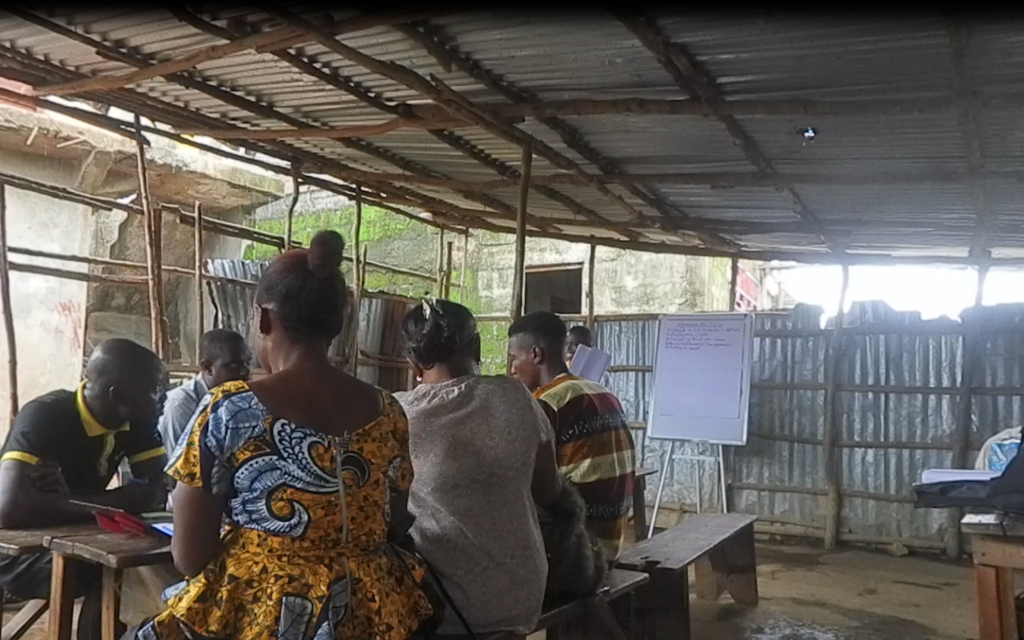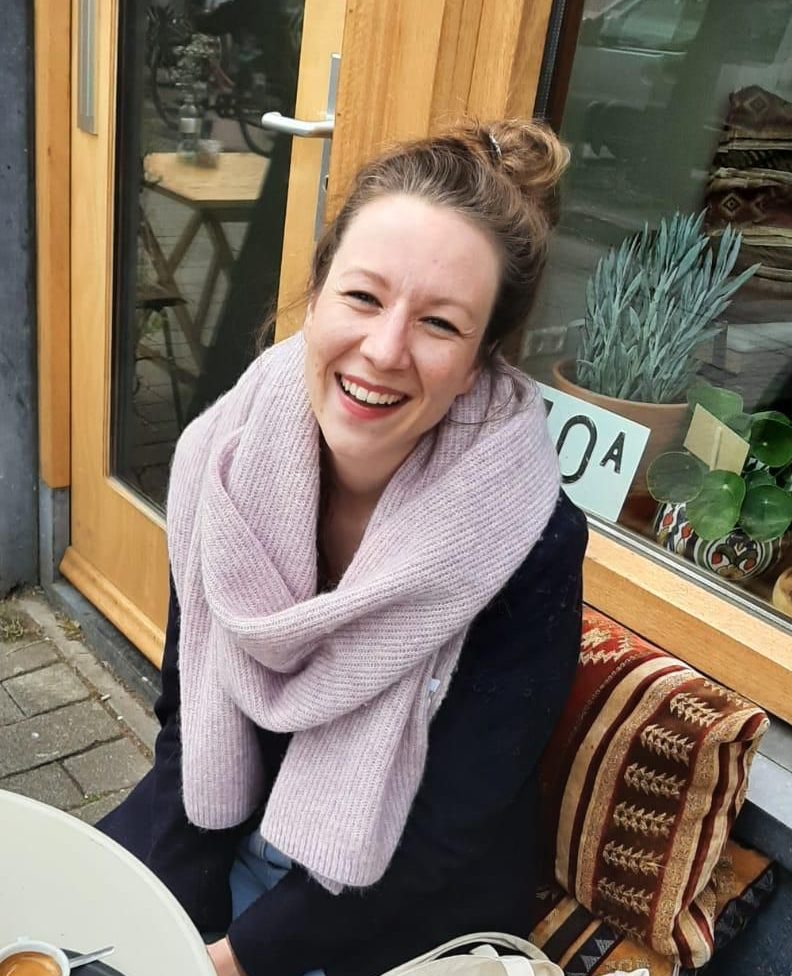When we step into the head-teacher’s office in one of our project schools, Foday, the facilitator comes in and greets us. He asks us to be patient while they sort out lunch for the children and get the teachers together. We sit back and relax, and watch the hundreds of learners receive their rice and plasas under the supervision of their teachers. We are there to observe a TGM: a Teacher Group Meeting. Teacher Group Meetings are meetings where teachers come together to share challenges and advice. Their aim is to facilitate an environment wherein teachers share knowledge and skills, and improve their practice through peer-learning. The facilitators are teachers who were chosen by their school leader to run these meetings and attended a one-day workshop in preparation for that. During the workshop, they learned about facilitation: how to create a safe environment during the TGMs and to encourage interaction between teachers. Facilitators were also offered materials and a structure for facilitating a TGM, which they altered to fit their own unique school contexts and their colleagues’ needs.
In 2018, Sierra Leone launched its Free Quality School Education Programme and although the primary school enrolment rate increased significantly in 2019, children only receive an average of 4.5 learning-adjusted years of schooling by the age of 18 (⇡UIS,2019; ⇡World Bank,2018). Teachers are under pressure to deliver quality education; however, levels of unqualified teachers are high, in particular at the primary level (⇡Mackintosh, et al., 2020). As part of the Free Quality School Education Programme, a national framework for school-based continuous professional development for teachers will be rolled out by the Ministry of Basic and Senior Secondary Education (MBSSE). Through working closely with teachers in the design, implementation, and evaluation of the TGMs, our study aims to better understand the barriers and enablers of this model.
The study focussed on 10 primary schools in Western Area Rural, on the Freetown Peninsula, and through three cycles of implementation (figure 1), feedback, and adaptation we learned what works and what doesn’t work well with TGMs.
Figure 1: Three cycles of Design-Based Implementation Research
Once the children have received their lunch, several teachers gather under a tin roof next to the school. It started to rain, and the children need to be watched inside the school, so the teachers had to find another space for their meeting. The heavy rain on the roof makes it difficult for teachers to hear each other. The head-teacher doesn’t attend the session, because he is watching the children, so the other teachers can join. Most teachers have joined, although they express that it is an inconvenience for them to stay after school hours. Our observation of their TGM, on this rainy Friday afternoon, highlights the opportunities and challenges of the TGMs.
The story of the TGM
TGM as an enabler for peer learning
During the TGM, we observe the interaction between teachers, sharing feedback, new ideas, and practices. “No man is an island”, as one of the teachers stated in an interview, and TGMs can facilitate an environment wherein teachers feel free to share struggles and successes:
“You bring some ideas, we share the ideas together, you see they ask us what are our constraints. You should not be ashamed to meet your friend if you have difficulties in your teaching, because no man is an island. We learn from each other.”
This also suggests that the TGMs potentially lift barriers to asking for help and that they can contribute to team cohesion.
TGMs can create conditions for reflective learning, i.e. giving constructive feedback, talking about mistakes and challenges, as well as sharing successes. When they work effectively, teachers and school leaders have reported seeing positive changes in classroom practices. In addition, with activities focussed not just on the learner, but also on the teacher’s well-being, the TGM offers a space where the teacher is placed at the center. A mood tracker, for example, prompts self-reflection and opens a space for support from colleagues.
Facilitators
Facilitators are key to the success of these meetings. Due to the fact that there are no material incentives provided (i.e. lunch, money, etc.) it is up to the facilitators to find a way to encourage their colleagues to attend. In addition, the quality of the meetings relies heavily on the facilitators’ commitment and input. Teachers are generally positive about the facilitators’ ability to “come down to their level” to explain. Schools where the meetings were less successful, and where teachers were not motivated to attend, showed lower levels of commitment and preparation from the facilitators. Equally, in schools where the facilitators were well-prepared for the session, teachers were more engaged and motivated. Facilitators themselves report experiencing their role positively: “I feel great because, for me to stand amongst my colleagues, to facilitate them to ask them questions about to stand up as a role model to guide them is something utterly good for me.” Nonetheless, they also indicate that they need continuous support and feedback, as well as a certificate or monetary incentives in return for their extra time.
School leaders
In addition to the facilitators, there is also a strong role for the school-leader. School-leaders are pivotal in creating incentives for teachers to attend. They can also add to the quality of the meetings. While we are observing the teachers during their meetings outside under the tin roof, the school-leader is watching the children. In other schools, head teachers provide transport money or lunch in order to encourage staff members to attend. When school-leaders are engaged, they can also provide support to the facilitators during the session, as well as function as role models and give advice to more junior teachers.
The limit of time
As we observe the session in our school, the half an hour that was reserved for the session comes to an end. Through a democratic process, teachers decide to extend the session up to one hour, so that all the activities can be covered. This illustrates one of the main challenges of organising TGMs in schools in the current setting: the limit of time. This challenge consists of two parts. First, due to the fact that teachers and facilitators have to find time around classes for the session, and because this puts a significant strain on teachers, they often limit the duration of the session. This results in not having enough time to get through the entire agenda. In addition, teachers are either disturbed by colleagues, parents, and learners if the session is organised during the lunch break, or they have other commitments when the session is organised after the last class. Second, 33% of primary school teachers are volunteers, and for teachers on the payroll, salaries do not cover the basic needs for living. Therefore, most teachers will have other sources of income after school hours. Teachers, and female teachers, in particular, have also reported not being able to attend after-school hours because of domestic duties or the care of children.

Materials
Materials for the TGM can enable facilitators, depending on the format and the medium through which they are provided. Our TGM observations revealed that the video content shared through the WhatsApp group, as well as the activities modeled during the workshop, were more popular than the activities from the guide. One of the facilitators admitted:
“as for me, I don’t have enough time to read that is my problem. Because I have so much work to do after school I’m a single parent so maybe like around two o’clock in the morning, I will be able to read my manual.”
This indicates that although written materials can enable facilitators, other factors, such as their limited time, prevents the effective use of the materials. Video and audio content shared in the facilitator’s WhatsApp group was popular. The platform was also used to ask for clarification about content, and facilitators from different schools used the platform to get in touch with each other to observe TGMs at each other’s schools. This suggests that the use of EdTech as part of school-based teacher professional development should be further explored.
Content
Just like materials, the content for the TGM can enable teachers to improve their classroom practice and their well-being. In the first cycle of our study, TGMs consisted of collective reflection and peer-learning, without new pedagogical input. In cycle 2, in addition to the collective reflection, interactive teaching activities were introduced and practiced. Cycle 3 content covered the well-being of learners and teachers, including a mood tracker for teachers, role-play activities, and strategies for improving teacher-learner relationships. Both the collective reflection and the pedagogical content were valued by teachers, and the cycle 3 content focussed on well-being in particular. Teachers appreciated that their well-being was prioritized and how that related to their relationships with their students and as a result their ability to learn.
Teaching conditions
Cycle 3 content focussed on well-being, opening a window to discuss the conditions under which teachers have to work. Poor salary conditions, overcrowded classrooms, the lack of materials, and the low appreciation of their profession puts a significant strain on teachers’ well-being. During today’s observation of the TGM, one of the teachers commented: “we are supposed to deliver quality education, but teachers themselves are not considered as professionals, so how can we deliver quality?”
Back in Western Rural, the time for this TGM is up. Not all the activities were covered, but a significant effort had been made to get through the agenda. Teachers are ready to go home and get on with their day but not before having some lunch together. The children have gone home and the rain has ceased. We go back inside and share rice and sauce from a big round plate. Teachers talk and laugh and urge us to make sure these findings get to the people who have the power to change their circumstances.
In order for TGMs to really live up to their potential to support teachers in their professional development, the structural challenges that teachers face need to be addressed, so that they are empowered to deliver quality education.
Resources
-Tich Ar Tich them in our Evidence Library
– Previous Tich Ar Tich Dem blog
– E-cubed: Learn more about the programme
– Image by Manfred Steger in Pixabay
– Foday is a fictional name
– Plasas: a popular type of sauce, often with a base of red palm oil and leaves, such as cassava leaves or potato leaves.


